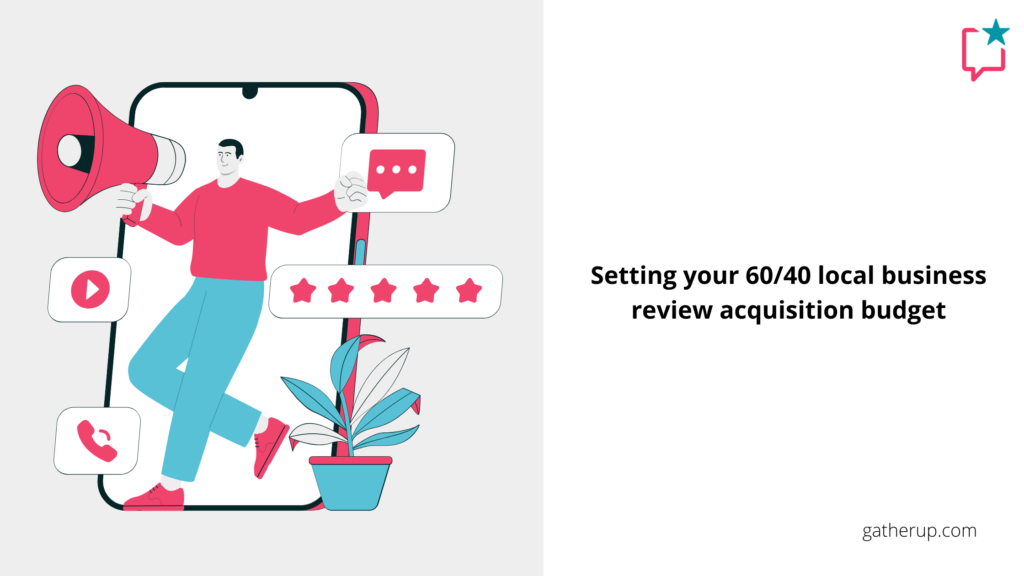
“Which platforms should the local businesses I’m marketing be getting reviews on? How should I prioritize review acquisition efforts?”
Given the power of reviews to earn the trust of the consumer public, influence searcher behavior, and drive conversions, leads, and sales, these reputation management FAQs are majorly important.
If you focus too much on earning reviews on the wrong platforms, you could be wasting time on unnecessary work. If you don’t budget enough time on certain platforms, you could be missing out on profitable opportunities.
Today’s column will teach you a simple methodology for envisioning your review request efforts as a 60/40 proposition so that you are wisely budgeting resources for positive reputation growth over time.
Need-to-know stats on reviewer behavior
These statistics, drawn from our extensive review survey of 1,200 US-based respondents, reveal current trends in review writer behavior. As we can see from the above chart, a dominant 60% of reviewers publish their content in the Google Business Profile environment, while the remaining 40% engage in this activity across a variety of other platforms including Amazon, Yelp, TripAdvisor, Facebook, Nextdoor, local community hubs, industry-specific sites, and various social media destinations. Reviewer habits are quite diverse.
It would be natural to conclude from this chart that if 60% of reviewers are focusing on leaving Google Business Profile (GBP) reviews, then you should be dedicating 60% of your efforts to earning reviews on this platform, using the remaining 40% of your time to seek reviews on the remaining sites.
But hang on…that might not be the right takeaway from the data for specific companies you’re tasked with marketing.
Are you on track 1, 2, or 3?
For this exercise, imagine that you’re handling reputation management for 3 different businesses. Here’s a summary of the current review status of each:
| Track 1 | Track 2 | Track 3 |
| Business 1 is well-established, with the following achievements: They have earned a competitive number of GBP reviewsThey have earned a 4+-star average GBP ratingThey are highly visible in local packs, finders, and Maps for their most important search phrases | Business 2 is growing, and looks like this: They don’t yet have a competitive number of GBP reviewsTheir average GBP star rating could be improved with more effortThey haven’t yet achieved high visibility in local packs, finders, and Maps for their most important terms. | Business 3 is new or unmarketed and: They have few or no reviews anywhere yetEvery new review will have a huge impact on their average GBP star ratingThey have a long road ahead to become competitive on any review platform |
If a business you’re marketing is on Track 1
Unless a dramatic change occurs to the competitive scenario in their market (like a new competitor edging them out), your Track 1 business is unlikely to need to devote 60% of its review acquisition efforts to Google. The level of achievement they’ve reached will typically mean that they can go into maintenance mode in the GBP environment, counting on the fact that 60% of reviewers are already focused on writing on Google without having to be asked.
Devoting 40% of the budget to acquiring new GBP reviews will likely be enough to keep the Track 1 business fresh, competitive, and visible. They have an excellent opportunity to allocate the remaining 60% of their review acquisition tactics elsewhere, potentially earning new business by becoming dominant on other platforms.
If a business you’re marketing is on Track 2
They haven’t yet achieved their GBP-centric goals. Set benchmarks for establishing a 4+ average star rating, a competitive review volume, and strong visibility for the brand’s most important search phrases in the Google environment.
Given Google’s massive role in local consumer journeys, it makes sense to devote 60% of the review acquisition budget to their platform until benchmarks are achieved and the company becomes a Track 1 business. I’d actually be inclined to steal time from the remaining 40% of the budget until these goals are met, building up a modest presence on other platforms until the brand has become a top competitor in its geographic market in Google’s system. Only then would I be comfortable switching to the Track 1 pattern.
The Track 2 ratio might look like this: 70% of the time spent strengthening their Google presence with 30% expended elsewhere to observe which other platforms look like strong reputation hubs for their business and community.
If a business you’re marketing is on Track 3
They are a blank slate with major work ahead of them. In nearly every case, Google will play the most powerful role in sending them future discovery, clicks, calls, requests for driving directions, leads, conversions, and sales.
In this scenario, the Track 3 business may be best served by robbing nearly all of the 40% budget until it becomes a Track 2 business. Their equation might look like 90% of time spent acquiring new reviews on Google, with the remaining 10% sprinkled elsewhere to begin identifying strong reputation candidates for future focus.
The time it will take to reach Track 2 status will be different for every brand, based on:
- Its category (some business types simply receive more reviews than others)
- The competitive level of its market (upward ranking movement can take a strenuous SEO and marketing effort in towns and cities with powerful, entrenched competitors)
- The effectiveness of its outreach (successful review requests require organization and skill – GatherUp can help!)
- The quality of its customer service (72% of reviewers are motivated to write reviews after experiencing excellent customer service)
Both Track 2 and 3 businesses should be doing all they can to reach the Track 1 plateau that will enable them to adopt that 60/40 scenario of maintaining their top competitor status on Google with a 40% effort while making the most of exploring other platforms and communities with the remaining 60% of their budget.
Beyond the Google wall: exploratory review acquisition
It should feel like getting a breath of fresh air when a business you’re marketing can shift some focus away from the Google grind. Regardless of which track a brand you’re marketing is currently in, all non-Google efforts should be conducted with an eye to figuring:
- Where the community being served is already leaving reviews for similar businesses
- Where the community might be receptive to leaving reviews if asked
Let’s take a closer look at what GatherUp’s survey respondents told us about their review writing activities:
- 48% write on Amazon
- 38% write on Yelp
- 35% write on Facebook
- 28% write on TripAdvisor
- 24% write on Apple Maps
- 16% are writing on local community hubs
- 12% are writing on social media
- 11% write on Nextdoor
- 9% are writing on industry-specific sites
When it comes to review acquisition, these numbers require provisos. For example, you need to throw Yelp out of the mix because their policies forbid local businesses from asking for reviews. If you want to build up your Yelp reviews, you’ll need to try other tactics like promoting the fact that your business is on Yelp instead of sending formal review requests.
Meanwhile, all of the above numbers are averages, meaning that they take all US geographies and business categories into account. The goal of being exploratory with your non-Google review acquisition budget is to discover which platforms are actually the best fit for your specific brand and community. For example, TripAdvisor is a mainstay of the hospitality industry, while Apple Maps (aka Apple Business Connect) may be on the rise in your town or city, especially amongst iPhone users for whom this platform is a default setting.
Your industry may have special platforms devoted to its category (like Findlaw for lawyers or ZocDoc for medical practitioners), or the community you work in may have a thriving city or neighborhood hub specific to your geography.
Finally, when it comes to social media, we move into informal territory as regards consumer sentiment. For example, an Instagram user posting a reel of themselves eating cinnamon rolls from your bakery and heaping lavish praise on your brand may not be writing a formal review of the kind you earn on GBP, but they are absolutely empowered to impact your reputation and send business your way. For some brands, social channels are major movers.
Review acquisition mindfulness and fluidity
While the goal is to get the businesses you market into Track 1 so that their horizons expand to encompass further exciting review opportunities, it’s important to emphasize these three factors to clients and teams:
- Local business online visibility and reputation are dynamic and can literally change overnight. It’s essential to continuously track the performance of each branch of a business to quickly catch changes to its competitive scenario.
- When changes occur and a location loses ground to a competitor, a fluid approach is necessary to reallocate review acquisition budget. A Track 1 business can find itself falling back into a Track 2 position if a competitor begins making a new and strong investment in their SEO and marketing, if customer service is neglected and ratings begin to suffer, or if some other change at the company results in fewer or worse reviews coming in. Achieving 60/40 is not a permanent status. It has to be maintained over time.
- There are always outliers to any examples. You may be in a vertical or geography in which reviewer behavior differs widely from the norms. For instance, schools aren’t allowed to receive reviews in Google’s system, so developing a strong reputation for excellence as an educational institution will not involve even a 1% Google effort. 100% of your budget will need to go elsewhere. Commit to putting in the work to find the right balance for the people you serve, because their needs and wants are your top priority.
Summing Up
The 60/40 ratio is a useful starting point for understanding how to budget review request resources, but as we’ve seen, figuring out the current track a business is existing in will help you create a more nuanced strategy. 60/40 can be seen as a goal, but even when you get there and are getting to allocate lots of time to exploring beyond the Google wall, it’s not a permission slip to ignore your GBPs from there on out.
Google remains so dominant a vehicle for brand discovery and consumer choice, it nearly always has to be maintained, particularly because rankings and ratings can alter drastically based on changes in the competitive landscape and within the business itself.
The good news is, Google is not your ONLY option. There is a growing world of other opportunities for building up the good name of your brand across the web. Pairing exceptional customer experiences with organized review acquisition can make a business a star in many online communities.
Start building a smarter review acquisition plan with GatherUp today. Learn How
